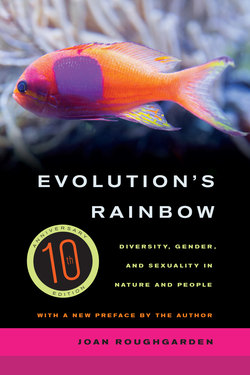Читать книгу Evolution's Rainbow - Joan Roughgarden - Страница 7
ОглавлениеPreface to the 2013 Edition
After ten years, Evolution’s Rainbow still offers a valuable overview of how diverse the sexuality and gender expression is among animals and people. Part of this book’s lasting value is how it brings the scope of this diversity together in one place.
Another value is that this book’s approach is biological, whereas most books about sexuality and gender come from the humanities or medicine. My approach is what a Martian biologist would take in an expedition to Earth. A newly arriving Martian would gaze about to discern the diversity here in animals, including humans. As you read this book, imagine you’re a young Darwin, not the bearded, aged thinker of most photographs but the young lad trying to discover just what’s “out there”—the Darwin who jumps ashore in the Galápagos to marvel at the strange and surprising creatures he finds. As you jump ashore onto the field of sexuality and gender, you too will find many surprising facts. The task is to scope out this diversity, not to explain it but to accept it and put it all on the table for further discussion later on. I wrote this book with the mind-set of an expeditionary biologist, like those in the 1800s or a Martian visiting Earth today. I knew that the stereotypes of male and female behavior weren’t accurate in animals and suspected they weren’t accurate for people either. So this book is an expedition to find out what is going on out there.
This book also shines a searchlight on the inadequacies of existing science to account for the diversity in gender and sexuality it now knows about. Scientists today are interested, so they say, in research that is “transformative,” and the major science-funding agencies of the U.S. government and some private foundations claim to be seeking proposals for work that satisfies this aim. However, two kinds of scholarship are transformative—extensional and destabilizing. Extensional research is easy to be enthusiastic about—it’s usually risky, but wow, if it works, then it can answer all sorts of questions. Extensional research often involves developing a new technology and applying it to long-standing empirical problems. Destabilizing scholarship can be just as transformative as extensional research. But instead of enthusiasm, defensiveness and hostility invariably greet it. No one wants to see their cherished theories dashed to the ground, becoming a midden of broken ideas. Evolution’s Rainbow is transformative and destabilizing. The main tool for destabilizing scholarship is criticism. Of course, transformation is only complete when reconstruction succeeds the destabilization. My efforts at reconstruction appear in my sequel to this book, The Genial Gene.1 Evolution’s Rainbow sets the table for the reconstruction that is beginning to take place now.
This book criticizes a venerable account of “universal” male and female gender roles that Darwin wrote about in 1871 under the heading of “sexual selection.”2 This account may already be familiar to you from popular media and nature shows that portray males as universally promiscuous and females as always choosy and coy. These male and female traits are purported to explain, for instance, why the peacock has a lovely tail—promiscuous peacocks are supposed to advertise their tails to peahens, who then choose only the most beautiful as their mates. This book illustrates how absurd these stereotypes are when faced with the real facts of life. In response to my critique beginning with this book, many biologists are redefining sexual selection so that it no longer refers to sex roles such as promiscuous male and coy female. Sexual selection has been redefined to be more generic, referring now merely to any traits that evolve because of competition for mates without attributing any general characteristics to males or females.3 This revised definition is much better than the early sex-role version this book criticizes. I regard this revision as a healthy reconstruction of sexual selection provoked by this book and my subsequent writings. Of course, this reconstructed version of sexual selection may still often be incorrect if traits thought to evolve in response to competition for mates actually evolve in response to some other form of natural selection, such as those involving cooperation between males and females, as The Genial Gene describes. The generality of the revised version of sexual selection is presently an open research question in biology.
Evolution’s Rainbow has now appeared in translation in Brazilian Portuguese and in Korean, and The Genial Gene in French. Also, a talented graphic artist, Gwen Seemel, has written and illustrated a lovely book that features many of the animal species discussed here and is suitable for children, titled Crime against Nature.4 I hope you join the many readers who have enjoyed and benefited from Evolution’s Rainbow.
Joan Roughgarden
Kapa’a, Hawai’i
April 17, 2013
NOTES
1. J. Roughgarden, 2009, The Genial Gene, University of California Press.
2. C. Darwin, 1871, The Descent of Man and Selection in Relation to Sex, John Murray.
3. D. M. Shuker, 2010, Sexual selection: Endless forms or tangled bank?, Anim. Behav. 79:E11-E17.
4. G. Seemel, 2012, Crime against Nature: A More Accurate Telling of What’s Natural, self-published.
